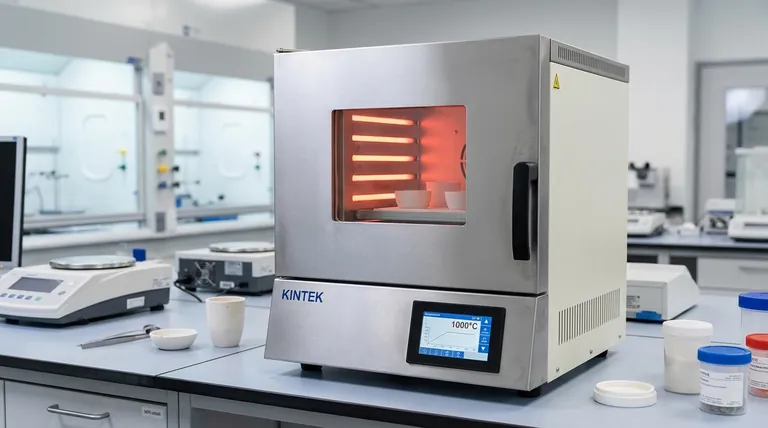In essence, a chamber furnace is a high-temperature insulated box designed for thermally processing materials in a controlled environment. These units are fundamental in laboratory and industrial settings for performing functions such as drying samples to remove moisture, baking to heat them without dehumidification, and curing to induce physical or chemical changes.
The true value of a chamber furnace lies not just in its ability to generate high heat, but in its capacity to create a stable, uniform thermal environment, which is critical for fundamentally altering a material's properties with precision.

The Core Principle: Contained and Controlled Heat
The design of a chamber furnace is centered on one primary goal: achieving and maintaining a specific, uniform temperature within an enclosed space. This is accomplished through a few key components working in concert.
The Insulated Chamber
The "chamber" is the heart of the furnace. It's a box constructed from refractory, or heat-resistant, materials. This heavy insulation minimizes heat loss, allowing the furnace to reach very high temperatures efficiently and maintain thermal stability.
The Heating Elements
Heating elements, typically electric coils made from high-resistance alloys, are strategically placed within the chamber. Their placement is engineered to distribute heat as evenly as possible, eliminating hot or cold spots that could compromise a process.
Precise Temperature Control
Modern chamber furnaces are equipped with sophisticated control systems. A thermocouple measures the internal temperature, and a digital controller adjusts the power to the heating elements to precisely follow a programmed temperature profile, whether it's a simple hold temperature or a complex ramp-and-soak cycle.
Key Functions and Applications
While the principle is simple, the applications are diverse and critical for many technical fields. The furnace's function is defined by the temperature and time it applies to a material.
Drying and Baking
At the lower end of its temperature range, a chamber furnace is used for high-performance drying and baking. This involves removing moisture or other volatile compounds from a sample more thoroughly than a standard oven could.
Curing
Curing is a process where heat is used to trigger a chemical reaction. This is common for hardening materials like polymers, epoxies, and composites, transforming them from a liquid or pliable state into a rigid, solid one.
Annealing and Heat Treatment
This is a classic high-temperature application, especially for metals and glass. Annealing involves heating a material to a specific temperature and then slowly cooling it to relieve internal stresses, increasing ductility and reducing hardness.
Ashing and Sintering
Ashing involves heating a sample to burn away all organic material, leaving only the inorganic components for analysis. Sintering is a process where fine powders are heated to just below their melting point, causing the particles to fuse together into a solid piece.
Chamber Furnace vs. Standard Oven: A Critical Distinction
It's common to confuse a chamber furnace with a simple laboratory oven, but their capabilities and intended uses are vastly different. Understanding these differences is crucial for selecting the right equipment.
Temperature Range
This is the most significant differentiator. Standard ovens typically operate up to around 250-300°C (482-572°F). Chamber furnaces, by contrast, start around this temperature and can reach 1200°C (2192°F) or much higher, depending on the model.
Temperature Uniformity
Because processes like heat treatment are highly sensitive to temperature variations, furnaces are engineered for superior temperature uniformity. This ensures that the entire sample or component experiences the exact same thermal conditions.
Construction and Durability
A furnace is built with robust refractory brick or ceramic fiber insulation to handle extreme thermal stress. An oven uses less dense insulation, like mineral wool, sufficient for its lower operating temperatures but unsuitable for the thermal demands of a furnace.
Making the Right Choice for Your Goal
Selecting the correct thermal equipment comes down to the temperature and precision your process requires.
- If your primary focus is simple drying or warming below 250°C: A standard laboratory oven is the more efficient and cost-effective tool.
- If your primary focus is material transformation: You require a chamber furnace for processes like annealing, ashing, sintering, or advanced curing.
- If your primary focus is repeatability for sensitive processes: The superior temperature control and uniformity of a chamber furnace are essential for achieving consistent results.
Ultimately, choosing the right instrument ensures that your material is processed under the exact thermal conditions required for success.
Summary Table:
| Feature | Chamber Furnace | Standard Lab Oven |
|---|---|---|
| Max Temperature | Up to 1200°C+ | ~250-300°C |
| Primary Use | Material transformation (e.g., annealing, sintering) | Drying, baking |
| Temperature Uniformity | High (engineered for precision) | Standard |
| Construction | Heavy-duty refractory insulation | Lighter insulation |
Ready to achieve precise thermal processing in your lab? KINTEK specializes in high-performance chamber furnaces and lab equipment designed for reliability and superior temperature control. Whether your needs involve annealing, curing, ashing, or sintering, our solutions ensure consistent, repeatable results. Contact our experts today to find the perfect furnace for your laboratory's specific requirements!
Visual Guide

Related Products
- 1400℃ Laboratory Quartz Tube Furnace with Alumina Tube Tubular Furnace
- Laboratory Quartz Tube Furnace Tubular RTP Heating Furnace
- Vertical Laboratory Quartz Tube Furnace Tubular Furnace
- Laboratory Muffle Oven Furnace Bottom Lifting Muffle Furnace
- 1700℃ Laboratory Quartz Tube Furnace with Alumina Tube Tubular Furnace
People Also Ask
- What material are furnace tubes? Choosing the Right Material for High-Temperature Success
- What are the benefits of a tube furnace? Achieve Superior Temperature & Atmosphere Control
- What are the advantages of a tube furnace? Achieve Superior Temperature Uniformity and Control
- What is a tube furnace used for? Achieve Precise, Controlled Thermal Processing
- What precautions should be taken when using a tube furnace? Ensure Safe, Effective High-Temperature Processing



















